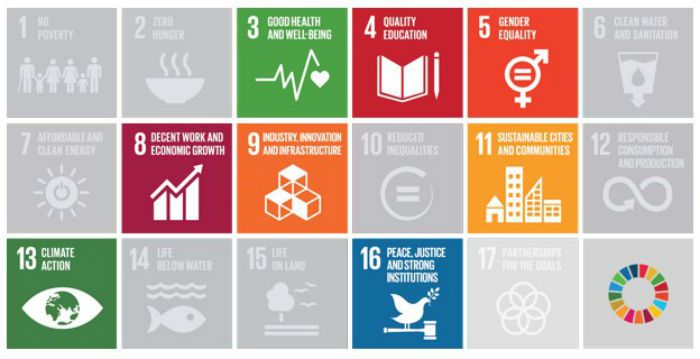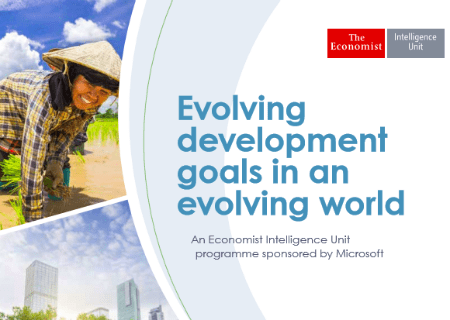Empowering countries through technology
At the United Nations General Assembly this week we’ll discuss the myriad of ways that country leaders plan to achieve the UN Sustainable Development Goals (SDGs) by 2030. 193 countries signed on to these goals last year, which focus on solving major, global societal issues related to economic, social and environmental challenges.
We are committed to all 17 goals, but believe that ICT can rapidly accelerate progress on eight. As we focus on these eight, we will leverage our solutions, partners, programs and services as we look to empower countries to compete in a dynamic, global economy.
 We believe technology can be a powerful enabler to solve many of the challenges facing public sector agencies today as they focus on the future of our planet and its people. As it turns out, government leaders also see technology as a very powerful lever to meet government goals. We commissioned a survey with the Economist Intelligence Unit where world leaders ranked their priorities and challenges in relation to the SDGs and outlined the strategies and investments they’re making to accomplish their goals.
We believe technology can be a powerful enabler to solve many of the challenges facing public sector agencies today as they focus on the future of our planet and its people. As it turns out, government leaders also see technology as a very powerful lever to meet government goals. We commissioned a survey with the Economist Intelligence Unit where world leaders ranked their priorities and challenges in relation to the SDGs and outlined the strategies and investments they’re making to accomplish their goals.
Government leaders recognize that technology can boost collaboration amongst government agencies and citizens, but also aid in providing citizens access to better jobs and education.
Let’s look at three areas where we’ve seen technology utilized as a powerful lever to make a difference:
Spurring Employment and Economic Growth:
According to the Australian Human Rights Commission, people with a disability are almost twice as likely to be unemployed and half as likely to have a full time job in comparison to people without a disability in Australia. Ensuring that people with a disability have the tools and technology that they need to be productive and fulfilled members of the workforce is critical to improving this imbalance.
With close to 4 million Australians (and 1.2 billion people worldwide) with a disability, we’re passionate about ensuring that our products and services are designed for people of all abilities.
That’s why we welcome the recent announcement that Australia will adopt the European standard for the procurement of accessible ICT: Accessibility requirements suitable for public procurement of ICT products and services. This clears the path for the standard to eventually be embedded into public procurement requirements to improve outcomes for people with a disability working in public sector agencies and helps governments ensure that all of the citizens they serve have equal access to information, services and the political process.
We’re also working hard to ensure that our products comply with emerging global standards. To help ensure organizations have the information they need about our product accessibility, we have for many years self-declared how we meet US Section 508 standards and have recently added conformance statements on how our products meet EN 301 549 and WCAG standards as well. Read our latest Microsoft Accessibility blog about Microsoft’s support for global accessibility standards.
Gender Equality:
According to the Global Gender Gap report of 2015, of the 3.5 billion women on the planet, 57% work outside the home, but only 17% in a professional job. And in the era of digital transformation, with every one digital job created for women, 20 jobs typically held by women will be displaced).
This exacerbates today’s gender gap, creating a digital divide that will displace women in the workforce. To combat this trend, we are embracing a new construct, which we call digital diversity. This construct calls for us to be mindful of the impact that digital transformation has on diversity and purposeful about creating opportunities that are inclusive of women and minorities. Further, we will strive to provide access to the skills that will allow women and minorities to land high growth jobs and allow them to prosper in the digital economy.
We are investing in many ways to increase the pipeline of girls and women in tech roles. We’re building key partnerships with the Anita Borg institute and the National Center for Women in Technology (NCWIT). We’re providing $75 million dollars in funding for greater access to computer science for under-represented groups through successful programs like DigiGirlz and TEALS. And we’re expanding our Explore Microsoft internship program which has a target of 50 percent diverse candidates.
Quality Education:
A quality education is critical to creating tomorrow’s doctors, engineers, teachers and leaders. And it lays the groundwork for solving the world’s greatest challenges. A critical part of that education for just about every job and sector today is understanding how to harness the power of technology to transform education and inspire learning to unlock potential everywhere.
Özel Dünya Koleji, a primary and middle school in western Turkey worked with Microsoft to introduce a wide variety of new software and services that have helped teachers utilize cutting-edge educational tools and methods. Now when the teacher provides the closing day announcements, she includes directions such as to “bring your tablets for the online lesson”, “check your OneNote notebooks for feedback on the last assignment you turned in” and “I’ve sent your parents an email about next week’s class presentations”. Teachers say that using new technology is giving students and parents confidence in the school.
We believe that, through our innovative cloud technologies and our engagement with political and business leaders, we can play an active role in helping to solve the world’s most pressing problems. There are many ways that you can show your support. I invite you to:
- Follow me on Twitter @ToniTWhitley as I relay our #MSFTempowers insights while at the UN GA this week
- Learn more about how we are Empowering Countries
- Learn this rap song so you are familiar with the SDGs
#MSFTempowers




